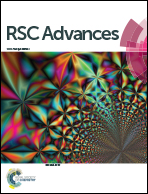Production of gold nanoparticles using atmospheric pressure glow microdischarge generated in contact with a flowing liquid cathode – a design of experiments study
Abstract
Direct current atmospheric pressure glow microdischarge (dc-μAPGD) generated between a miniature flow Ar plasma microjet and a small-sized flowing liquid cathode (FLC) was characterized with respect to the effects of the selected operating factors on the particle size of the synthesized Au nanoparticles (AuNPs). The factors that were investigated were the discharge current, the flow rate of the solution of the FLC, and the flow rate of the Ar plasma microjet-supporting gas. The effects of the individual factors and their inter-factor dependencies on the size and size distribution of the synthesized AuNPs were evaluated by changing the operating conditions according to the Box–Behnken design (BBD) plan and monitoring the wavelength of the maximum (λmax) of the localized surface plasmon resonance (LSPR) absorption band. The response surface methodology (RSM) was used to fit the experimental data with an appropriate regression model and optimize the plasma-reactor system to produce spherical AuNPs having the lowest particle size and size dispersion. It was established that a high discharge current and a low flow rate of the solution of the FLC facilitated the production of spherical, uniform and the smallest in size AuNPs. The correctness of the model was validated by producing the AuNPs in optimal and non-optimal conditions and the analysis of the resultant nanofluids by UV-Vis absorption spectrophotometry, dynamic light scattering (DLS), and scanning electron microscopy (SEM).


 Please wait while we load your content...
Please wait while we load your content...